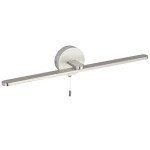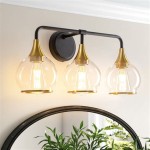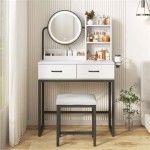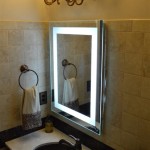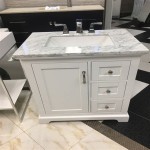Vanity Lights For Bathroom Mirror: Illumination and Aesthetics
Vanity lights for bathroom mirrors represent a crucial element in bathroom design and functionality. They serve the dual purpose of providing adequate task lighting for grooming activities and enhancing the overall aesthetic appeal of the space. Selecting the correct vanity lighting involves careful consideration of various factors, including the size of the bathroom, the style of the mirror, the desired level of illumination, and energy efficiency. Proper placement and selection of vanity lights contribute significantly to a well-lit and visually pleasing bathroom environment.
The importance of vanity lighting extends beyond mere aesthetics. Adequate lighting improves visibility, making tasks such as shaving, applying makeup, and styling hair easier and safer. Poorly lit bathrooms can lead to eye strain and inaccurate color perception, negatively impacting the outcome of grooming rituals. Therefore, investing in quality vanity lights is a practical decision that improves the daily routines and overall comfort within the bathroom.
This article will explore the key aspects of choosing and installing vanity lights for bathroom mirrors, focusing on different types of lights, factors to consider during selection, and best practices for optimal illumination.
Types of Vanity Lights
The market offers a diverse array of vanity light options, each with unique characteristics and suitability for different bathroom styles and needs. Understanding the various types available is essential for making an informed decision.
Light Bars: Light bars, also known as vanity bars or strip lights, are horizontal fixtures typically mounted above the mirror. These lights provide a broad and even distribution of light, reducing shadows and creating a flattering illumination for facial grooming. Light bars come in various lengths and configurations, with multiple bulbs or a single integrated LED strip. They are versatile and work well with a wide range of mirror sizes.
Sconces: Sconces are wall-mounted lights that flank the sides of the mirror. Placing sconces on either side provides balanced illumination, minimizing shadows and highlighting facial features. Sconces are available in numerous styles, from traditional to modern, and can be chosen to complement the overall bathroom décor. When selecting sconces, it's crucial to ensure they are positioned at an appropriate height to provide optimal lighting without creating glare.
Pendant Lights: Pendant lights are suspended from the ceiling and can be used as an alternative or supplemental source of vanity lighting. While pendant lights are more commonly associated with general ambient lighting, smaller pendants strategically placed on either side of the mirror can add a decorative touch while providing focused illumination. Pendant lights are particularly suitable for bathrooms with higher ceilings, where they can create a dramatic visual impact.
Recessed Lighting: Recessed lighting, also known as can lights, are installed within the ceiling and provide a discreet and unobtrusive lighting solution. While not specifically designed as vanity lights, recessed lights can be strategically positioned to supplement other vanity lighting sources, providing general ambient light to the bathroom and reducing shadows. Integrating recessed lighting with dimmers allows for customizable light levels to suit different needs and preferences.
Integrated LED Mirrors: Integrated LED mirrors feature built-in LED lighting around the perimeter of the mirror. These mirrors offer a sleek and modern aesthetic while providing even and shadow-free illumination. Integrated LED mirrors are becoming increasingly popular due to their energy efficiency and ease of installation. They often include features such as adjustable brightness and color temperature settings, providing greater control over the lighting environment.
Key Considerations When Selecting Vanity Lights
Choosing the right vanity light involves a thorough evaluation of several critical factors. Ignoring these factors can result in inadequate lighting and a less-than-desirable bathroom experience. Key considerations include size and placement, light output and color temperature, style, and energy efficiency.
Size and Placement: The size of the bathroom and the mirror significantly influence the choice of vanity lights. Larger bathrooms may require more light fixtures or higher wattage bulbs to achieve adequate illumination. The placement of the lights is equally important. Ideally, lights should be positioned to minimize shadows and provide even light distribution across the face. For light bars, the length should be proportional to the width of the mirror. For sconces, spacing them evenly on either side of the mirror at eye level is crucial.
Light Output and Color Temperature: Light output, measured in lumens, indicates the brightness of the light. The appropriate lumen output depends on the size of the bathroom and the desired level of illumination. For vanity lighting, a range of 400-800 lumens per fixture is generally recommended. Color temperature, measured in Kelvin (K), refers to the warmth or coolness of the light. Warm white light (2700K-3000K) creates a cozy and inviting atmosphere, while cool white light (3500K-4100K) provides brighter and more focused illumination. For tasks such as applying makeup, a neutral white light (around 3500K) is often preferred, as it provides the most accurate color representation.
Style and Aesthetics: Vanity lights should complement the overall style of the bathroom décor. Whether the bathroom design is traditional, modern, or transitional, there are vanity light fixtures available to match. Consider the finish of the fixtures, such as chrome, brushed nickel, oil-rubbed bronze, or matte black, and ensure they coordinate with other bathroom hardware, such as faucets and towel bars. The design of the light fixtures can also contribute to the overall ambiance of the bathroom, adding a touch of elegance or personality.
Energy Efficiency: Energy efficiency is a significant consideration, both for environmental reasons and to reduce electricity bills. LED (Light Emitting Diode) lights are the most energy-efficient option, consuming significantly less energy than traditional incandescent or fluorescent bulbs while providing comparable or superior light output. LED lights also have a longer lifespan, reducing the need for frequent bulb replacements. When selecting vanity lights, look for fixtures with the Energy Star label, which indicates that they meet stringent energy efficiency standards.
Best Practices for Optimal Vanity Lighting
Achieving optimal vanity lighting requires careful planning and execution. Following best practices during installation and usage ensures a well-lit and functional bathroom space.
Layered Lighting: Employing a layered lighting approach involves combining different types of lighting to create a balanced and effective lighting system. This approach typically includes ambient lighting (general room illumination), task lighting (focused illumination for specific tasks), and accent lighting (decorative illumination to highlight specific features). For vanity lighting, a combination of light bars, sconces, and recessed lighting can provide optimal results.
Dimmers: Installing dimmers on vanity lights allows for adjustable light levels to suit different needs and times of day. Dimmers provide greater control over the lighting environment, allowing users to create a brighter and more focused illumination for tasks such as shaving or applying makeup, or a softer and more relaxing ambiance for bathing or winding down before bed. Dimmers also conserve energy by reducing the amount of electricity consumed when the lights are not needed at full brightness.
Professional Installation: While some homeowners may be comfortable with DIY electrical projects, it is generally recommended to hire a qualified electrician to install vanity lights, particularly if the installation involves wiring or modifying existing electrical circuits. A professional electrician can ensure that the installation is done safely and correctly, complying with local electrical codes and regulations. Improper installation can lead to electrical hazards and damage to the lighting fixtures or the electrical system of the home.
Regular Maintenance: Regular maintenance of vanity lights is essential to ensure they function properly and maintain their aesthetic appeal. This includes cleaning the fixtures regularly to remove dust and grime, which can reduce light output. Replacing bulbs as needed is also important. When replacing bulbs, ensure that the new bulbs have the correct wattage and color temperature to maintain the desired lighting effect. LED lights typically require less maintenance than traditional bulbs, but it is still important to inspect them periodically for any signs of damage or malfunction.
By carefully considering the types of vanity lights available, key factors during selection, and best practices for optimal lighting, it is possible to create a bathroom environment that is both functional and aesthetically pleasing. Adequately illuminated vanity areas contribute to improved grooming routines, enhanced visual appeal, and overall comfort within the bathroom space.

Choosing Bathroom Wall Lights For Vanity Use

Letsun 24 Inch Dimmable Bathroom Vanity Light Fixtures 16w Led

Get The Perfect Bathroom Vanity Lighting You Deserve

Best Bathroom Vanity Lighting Lightology
:strip_icc()/101891918-f7fe1a2dce374ea69e9e31222728e741.jpg?strip=all)
30 Bathroom Lighting Ideas For Every Decorating Style

Sunpez 37 In 5 Lights Bathroom Light Fixtures Over Mirror Modern Led Vanity Lighting For Powder Room Bedroom Ym Jqd0593 The Home

Bathroom Lighting Discover Now Eglo

48in Modern Led Vanity Light For Bathroom Lighting Dimmable 46w Black Cold White

Gold Bathroom Vanity Lights Over Mirror Led 2 Light Frosted Glass Glob Cottagelifelighting

Vanity Lights With 6 Led Bulbs For Bathroom Lighting
